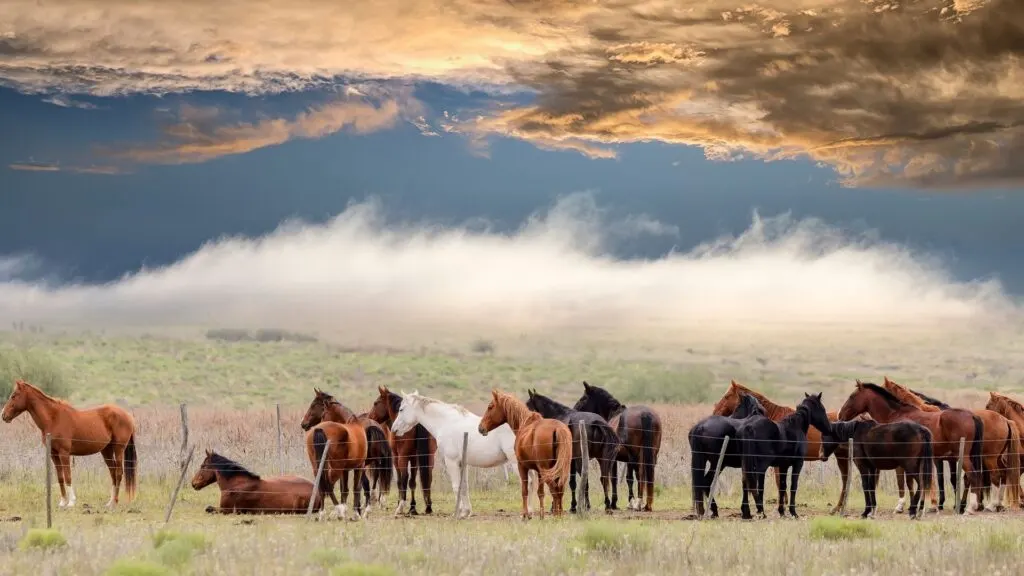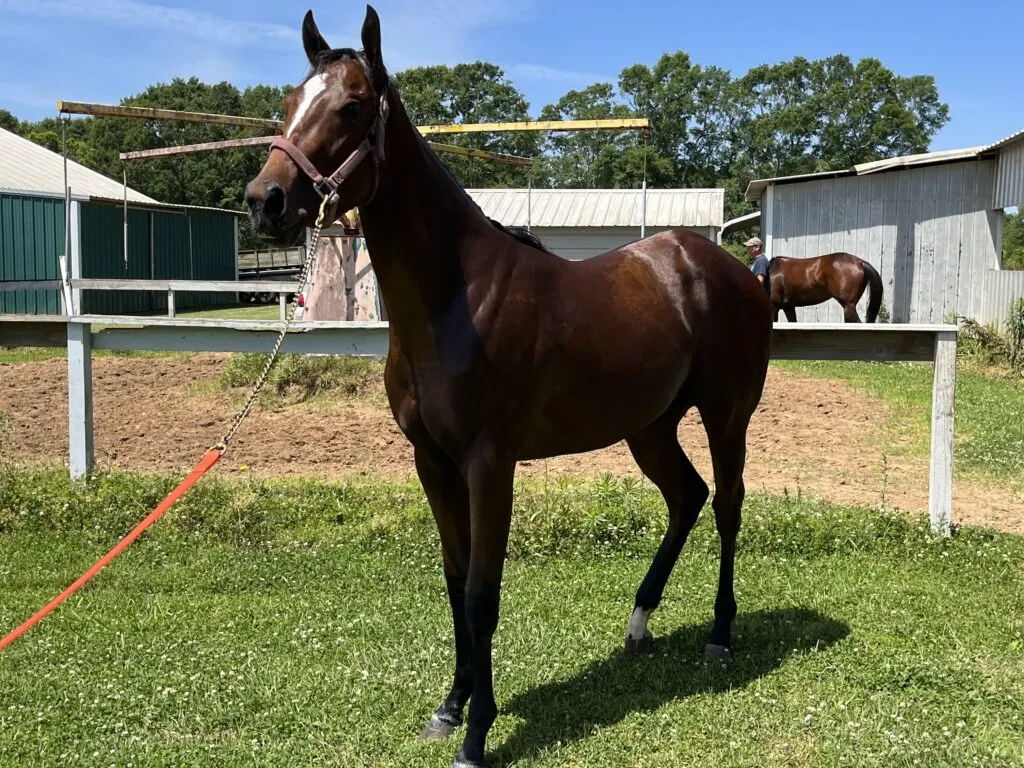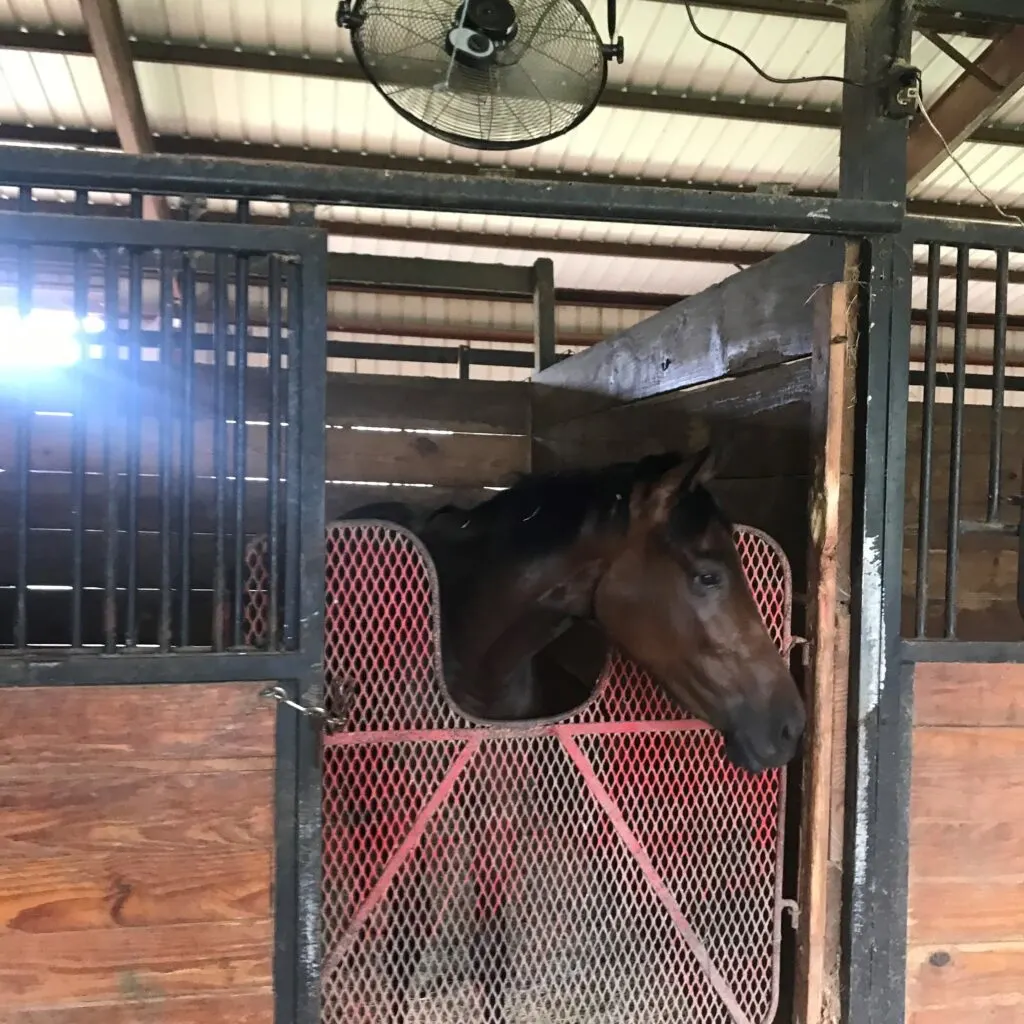Last updated: February 16, 2023
It’s fascinating to know that all horses have common characteristics, yet they may be raised differently and have different uses. Horses are individuals, but when you get down to basics, physical and behavioral characteristics apply universally to all horses.
Many characteristics make horses unique and interesting; they have physical traits like hoofs, huge eyes, and a relatively tiny stomach. Horses also behave in certain ways, such as grazing throughout the day and bolting when sensing danger.
Horses have many interesting characteristics; they can’t vomit if they wanted to and can sleep standing up; these are two of the fascinating traits of this animal. If you want to learn more about horse characteristics, then read on.
Topics covered:
- Some unique characteristics of a horse
- Physical characteristics of a horse
- Behavior and human characteristics horse display
- Interesting facts about horses
Six unique horse characteristics

Understanding a horse’s personality traits and characteristics can help you develop an effective relationship with it. This knowledge is also invaluable during training because you will know how your horse thinks, making the process easier.
Here are some of the most important characteristics of a horse:
1. Prey animals
Horses are prey animals, and they are always on the lookout for potential threats. Most horses are easily frightened by objects that we may not see as threatening at all.
It’s essential for you as a rider to train your horse not to be afraid of these things and desensitize it from noises so it doesn’t spook whenever something loud happens nearby – which could lead it to bolt before you know what’s happening.
2. Ever alert
Your horse is always on alert, sensitive, and aware of its surroundings. This is why your ‘friend’ will be pointing its ears in different directions at any moment to catch a sound you might not have noticed or even heard.
Horses also use these ear positions and subtle movements such as swishing tails to communicate with one another over long distances.
You might have heard of the term horse sense. This refers to the fact that the horse is keenly aware of the dangers around it. It is what helps a horse stay safe and avoid hazards.
3. Creatures of habit
It’s a good practice to feed, groom and train your horse at a set time every morning. Horses are creatures of habit who instinctually anticipate events throughout their day – which is why they are typically healthier and perform better on schedules.

4. Herd animals
Horses are social animals that rely on their herd for protection and companionship. As with any group of individuals, there is a “pecking order,” and each horse has a specific role or responsibility. These roles keep the members organized and safe.
The lead stallion and mare watch over all of them while keeping an eye out for threats from predators such as wolves, mountain lions, coyotes, etc.; while other horses have tasks like being sentries; tending newborns, and grazing, so not all need to eat at once – they work together!
Also Read: Horse Training: How To Establish Your Role as a Herd Leader
5. Sensitive creatures
Horses are sensitive and emotional animals, capable of forming deep loving bonds with humans. Whether they’re grazing in a group or enjoying the company of their human friend, most horses love to be around others.
6. Herbivores
Horses are herbivores, which means they eat forages (grass and hay) to maintain their strength and meet their nutritional needs. However, hard-working horses may need a diet supplemented with grains to give them more energy.
Check out my guide on Horse Hay: The Best Kind to Choose.

Physical characteristics of horses
Horses belong to the equine family. They are descendants of Equus. Here are some of their main physical traits:
- Body –A horse has long legs, a muscular body, and a strong topline. These traits help your horse run very fast and carry heavy loads.
- Teeth – A horse’s teeth and jaws are very large and strong. Their jaw strength helps them cut and chew thick hay and grasses. A horse’s teeth is so large that it takes up more space in its head than its brain. Check out my guide on Horse Teeth: How Many and Different Kinds.
- Eyes – The placement of eyes on either side of the head allows your horse to see in multiple directions simultaneously and accounts for their ability to see 350-degrees. Blue-eyed horses are rare, but some breeds do have them.
- Legs – The lower legs of a horse have no fat, which is one reason they can run faster than many other animals and helps them evade predators.
- Heart – Horses have strong hearts and can run for miles. Many endurance races are twenty miles long and some even further.
- Hoof – The hoof can be considered as a single toe covered with a tough layer of horn. They grow about a quarter-inch per month. Find out surprising facts on horseshoeing and whether it is a cruel process in this article.
- Colors and markings – Horses come in a variety of colors and markings. Black, bay, grey, chestnut, skewbald, roan, and flea-bitten grey are some common horse colors. Some horse breeds like the American Paint Horse are available in gorgeous patterns.
Also Read: Stunning and Gorgeous Rare Horse Breeds: 10 of the Most Endangered Horse Breeds

Three behavior traits horses display
Understanding the behavioral traits of horses can help us better care for our animals by knowing how to feed them correctly and giving them the right amount of exercise.
1. Horses graze most of the day.
Horses have been around for about 25 million years and have found a way to live in regions with poor quality food by grazing throughout the day. Horses evolved this incredible ability to extract and use nutrients from low-level forages while living on the plains of the Eurasian Steppe.
So it is not out of laziness that your horse grazes all day but rather necessity. Horses graze the majority of the day, and their way of eating involves slow, steady movement. Eating and moving serve two purposes: intake of food as well as exercise.
Horses confined in stalls daily need “turn out time” so that they stay healthy! Horses are naturally tolerant of temperature changes, and in the plains, they can experience extreme fluctuations.
Horses adapt to these drastic temperatures quite well; however, their personal needs could change depending on factors like age, activity level, and overall health.
Younger horses might not need any protection at night or when it is cold outside, while older ones will require a horse blanket to keep it warm when temperatures drop.
2. Horses communicate through body language.
Horses use a unique language that humans need to be able to understand in order to train them effectively. This includes vocal communication and body movement, such as neighing, head positioning, and pinning ears when angry.
As social animals with an intricate understanding of each other’s emotions, this is how horses communicate with one another too.
3. Horses need to move around.
A horse needs to move for some of its organs to function correctly and work properly. In the wild, they move almost the entire time they are awake, either searching for food, grazing, or walking to a water source.
Horses need to walk for various reasons, including wearing their hooves down and keeping their blood circulating. The hoof works like a pumping mechanism to return blood to a horse’s heart.
You should be house your horse to encourage movement as much as possible to maintain their health. If you keep your horse in a stall, you need to take it out each day to allow it time to exercise and move around.

Four human traits horses display – Your horse is more human than you think!
Human characteristics of a horse
Here are some similarities between horses and humans:
1. Horses can read human emotions
A horse can read its human handler in an eerily accurate manner. It can immediately tell when a rider is unhappy or nervous. There is a quote from Buck Brannaman that summarizes this beautifully:
The Horse is a Mirror to Your Soul, and Sometimes You Might not Like What You See in the Mirror.
This means that a horse can reflect your emotions and, at times, might even show you facets of your personality that you may not be aware of.
2. Horses and humans are pretty similar physically.
Horses and humans having similar traits might sound ridiculous, but in fact, they do share some common physical characteristics. While the horse has a larger bone structure, the number of bones humans and horses have is very similar- a horse has 205 bones, whereas humans have 206.
Both mammals have pelvises and a single stomach, but a horses’ stomach can digest cellulose fiber from the grass they eat while humans can’t.
3. Horses are smart
Horses are also smart, and you can train one to perform a wide range of athletics and acts. Check out my guide on Horse Intelligence, where I discuss how scientists test horse intelligence and how horses differentiate between patterns.
4. Horses have good memories.
Like most humans, horses have excellent memories. They forgive, but they won’t forget!
10 Interesting facts about horses.
1. Stiff upper lip, horses have a unique upper lip.
Horses have a prehensile upper lip. Prehensile means they can use their lips to grasp hay and other objects.
2. Horses have an extra eyelid
Horses have a nictitating membrane or a third eyelid. It originates from the inside corner of the eye and closes horizontally when the animal s grazing to protect the eyes from foreign objects.
3.There are still real wild horses
The last remaining truly wild horses are the Przewalski horses. They are also called Asiatic Horses, Mongolian horses, or Takhi. These horses have 66 chromosomes, while domesticated horses have 64.
4. Horses have strange dietary habits
Sometimes, horses eat strange things like dirt and wood. Foals also eat manure. Many horses swallow a lot of sand while grazing. That is why they need Psyllium husk fiber to absorb the sand and pass it through the intestine.
5. You can clone a horse.
In 2003, Italian scientists attempted to clone horses. Today, the procedure can cost up to $150,000, and breeders hopeful of duplicating winning horses use it to clone their best runners. But are cloned horses allowed to race?
6. Equine colleges, anyone?
Many major universities offer Bachelors’s, Master’s, and Doctorate degrees in different forms of equine studies. Near my home, at LSU, they have an excellent program for horse enthusiasts. Needless to say, students can bring in their own horses.
7. When a horse is carrying a baby, it’s in foal.
Humans give birth, dogs whelp, and horses foal. Foaling can take anywhere between 30 minutes to an hour, and most foals are born early in the morning or at night.
8. Farriers
A horse farrier is a person who specializes in taking care of horses’ feet, including shoeing them. The word ‘farrier’ comes from the Latin word for ironworkers.
Men and women can both become farriers, but because it’s strenuous on your back and joints, as well as always being at risk to get kicked by a hoofed animal – not many people choose this profession over more stable careers.
9. Horses have a sixth sense.
Horses, like humans, have five senses: sight, hearing, touch, smell, and taste. They also have a sixth sense – which helps them know intent. This sense also helps them sense fear, anger, joy, anxiety, and relaxation.
10. Some horses live a long time.
The oldest horse is believed to be Billy, who lived up to the ripe old age of 62 years!
FAQ
The characteristics associated with horses according to the Chinese Zodiac
In Chinese culture, each year is associated with an animal that reflects the characteristics of those born in that year. People who are born in the Year of Horse are said intelligent, independent, successful, and ambitious–traits that can help you achieve your dreams if you embrace them.
What are three interesting facts about horses?
1. Horses have tiny stomachs, theirs is the smallest of any domesticated animal in relation to their size.
2. Horses can sleep standing, they have a special locking mechanism in their leg joints they engage to keep them upright when sleeping.
3. Horses have huge eyes, they are larger than any other land mammal.
What are the mean horse breeds?
Horses typically only act aggressive or mean when treated poorly by humans or other animals; this is because their natural instinct is not to fight but flee from confrontation. However, hot-blooded horse breeds such as Thoroughbreds, Arabians, Akhal-Tekes, and Barbs are the quickest to fight back when confronted.
